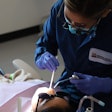Dental therapists could provide sorely needed care to millions of underserved Americans working in collaboration with dentists, suggests a new report by the W.K. Kellogg Foundation.
The report, "Training new dental health providers in the U.S.," by Burton L. Edelstein, D.D.S., president of the Children's Dental Health Project, offers an analysis of the training of dental therapists and other existing and proposed dental health professionals.
The dental therapist model, Dr. Edelstein said, is one that has a long history of successfully expanding care to underserved children as part of a comprehensive system of care managed by dentists.
The report notes that dental therapists in countries outside the U.S. typically receive two years of training for dental therapy alone and three years for combined dental therapy and dental hygiene immediately following secondary school. They work in quasi-independent arrangements with dentists. The advantage of these arrangements is that they expand the reach of dentists, allowing them to delegate basic services to therapists and consult with them as needed while providing more complex services themselves.
Based on a review of international training programs and the initial U.S. experience, the paper includes findings to be considered in developing new training programs for dental therapists:
- Trainees are recruited from the general population, with preference for those from underserved populations or committed to care of the underserved.
- Length of training is two years for dental therapy alone and three years for combined dental therapy and dental hygiene. Dental therapist training fits within a larger career-ladder structure.
- Supervisory arrangements afford dental therapists sufficient latitude to practice collaboratively with dentists while ensuring that patients and procedures requiring a dentist's expertise are provided by a dentist.
- Dental therapy education for two years or joint dental therapy/dental hygiene education for three years after high school, to deliver a specified subset of dental procedures is faster and less costly than training dentists who can provide a full range of dental services.
- Curricula stress clinical and socio-behavioral studies that prepare therapists for working with underserved populations.
- Training experiences focus on clinical competency over didactic knowledge and often engage trainees in community-based experiences.
- Oversight and accrediting agencies establish independent standards for two-year dental therapy and three-year joint dental therapy/hygiene education within the context of comprehensive systems of care.
"The assembled U.S. and international evidence suggests that the training of dental therapists in the U.S. to provide basic care can prepare them to expand the reach and efficiency of dentists and increase care for those who are currently underserved," Dr. Edelstein said.



















